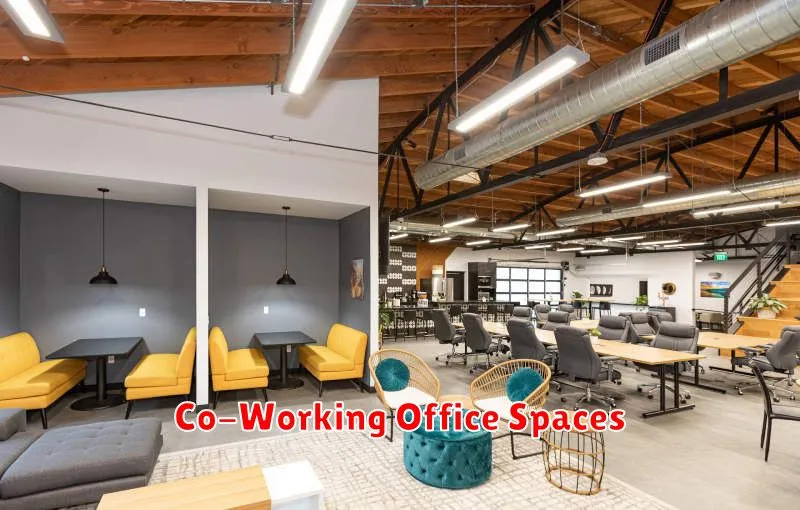Thinking about ditching your home office or cramped cubicle? Co-working office rentals are booming, offering a flexible and potentially cost-effective alternative. But are they right for you? This article dives deep into the pros and cons of co-working spaces, exploring everything from networking opportunities and increased productivity to cost considerations and potential distractions. Whether you’re a freelancer, entrepreneur, or part of a small team, understanding the advantages and disadvantages is crucial before making the switch. Let’s explore the world of shared workspaces and help you decide if a co-working rental is the perfect solution for your business needs!
What Is a Co-Working Office Space?
A co-working office space is a shared workspace where individuals or teams from different companies or organizations rent desks, offices, or other work areas. Unlike traditional offices, co-working spaces foster a collaborative environment. Members share amenities such as high-speed internet, printers, meeting rooms, and often a communal kitchen or lounge area.
Flexibility is a key feature. Contracts typically range from daily to monthly memberships, allowing for scalability based on a company’s or individual’s needs. This differs from traditional long-term leases which can be restrictive. The environment often promotes networking and a sense of community among its members.
Different co-working spaces offer varying levels of amenities and services. Some might be more basic, providing only desks and internet, while others offer more elaborate features like on-site childcare, fitness centers, or event spaces. The price typically reflects the level of amenities and services offered.
In essence, a co-working space provides a professional, shared work environment that’s generally more affordable and flexible than traditional office rentals.
Pro 1: Flexibility in Lease Agreements
One of the biggest advantages of co-working spaces is the flexibility offered in lease agreements. Unlike traditional office leases which often lock you into long-term contracts (sometimes years!), co-working spaces typically offer shorter-term agreements, often month-to-month. This provides significant adaptability for your business.
This flexibility is crucial for startups and rapidly growing businesses. You can easily scale up or down your space as needed, adding or removing desks or private offices to match your evolving workforce and budget. This avoids the costly penalties and complications associated with breaking a traditional long-term lease.
Furthermore, the short-term nature of co-working leases allows businesses to test different locations and office environments before committing to a long-term rental. This can be particularly helpful when you’re unsure about the best location for your business or need to quickly adapt to changing market conditions.
Pro 2: Networking Opportunities with Other Businesses

One of the biggest advantages of co-working spaces is the unparalleled networking opportunities they offer. Surrounding yourself with other businesses provides a fertile ground for collaboration and relationship building.
You’ll encounter individuals from diverse industries, fostering cross-pollination of ideas and potentially leading to valuable partnerships or referrals. The informal atmosphere often facilitates spontaneous connections, unlike the isolation of a traditional office.
Many co-working spaces actively promote networking through events, workshops, and shared social areas. This structured approach maximizes the chances of making meaningful professional contacts and expanding your business network significantly.
Ultimately, the networking benefits can translate into increased business leads, access to new markets, and collaborative projects that fuel growth and innovation. This organic networking is a significant return on investment for many co-working members.
Pro 3: Access to Shared Amenities
One of the biggest draws of co-working spaces is the access to shared amenities. Forget the expense and hassle of individually sourcing and maintaining these features. Instead, co-working spaces typically offer a range of resources designed to boost productivity and employee well-being.
These amenities can include high-speed internet, printing and scanning facilities, and meeting rooms of varying sizes, perfect for client presentations or internal brainstorming sessions. Many also provide kitchen areas with coffee machines and refrigerators, fostering a collaborative atmosphere and reducing the need for individual office supplies.
Beyond the basics, some co-working spaces go above and beyond. You might find comfortable lounge areas, standing desks, game rooms, or even on-site fitness centers. These extra perks not only enhance the work experience but can also contribute to a healthier and more engaged workforce.
The availability and specifics of shared amenities will, of course, vary depending on the co-working space and its pricing tier. However, the access to a range of convenient and professionally managed resources is a significant advantage that can save both time and money for businesses.
Con 1: Lack of Privacy for Meetings
One significant drawback of co-working spaces is the lack of privacy often associated with meetings. Unlike a traditional office, co-working environments are typically open-plan, meaning conversations can easily be overheard by others.
This can be a major concern for businesses handling sensitive information, conducting confidential client discussions, or simply needing a quiet space for brainstorming sessions. The constant ambient noise and lack of soundproofing can make focused discussions challenging and potentially compromise confidentiality.
While some co-working spaces offer private meeting rooms, these are often booked in advance and may come at an extra cost, negating some of the budget-friendly advantages of co-working. The overall lack of guaranteed privacy can be a deal-breaker for many businesses.
Con 2: Limited Customization Options
One significant drawback of co-working spaces is the limited customization options available. Unlike traditional office rentals, you typically have less control over the office’s design and layout. Pre-existing furniture, decor, and even the overall aesthetic might not perfectly align with your brand or team’s preferences.
This can be a major constraint for businesses that value a highly personalized and branded workspace. While some co-working spaces offer some level of personalization, it’s usually within predefined parameters. You might be able to choose your desk or office size, but extensive renovations or significant alterations are generally not permitted.
Therefore, if complete design freedom and customization are crucial for your business’s image or workflow, a traditional office lease might be a more suitable option. Consider the extent to which you need to tailor your workspace to your specific needs before opting for a co-working space.
Tips for Choosing the Right Co-Working Space
Choosing the right co-working space can significantly impact your productivity and overall work experience. Consider these key factors:
Location: Proximity to your home or clients is crucial. Factor in commute time and accessibility via public transport or parking.
Amenities: Assess the space’s offerings. Do you need high-speed internet? Meeting rooms? Printing facilities? A fully-stocked kitchen? Prioritize features essential to your workflow.
Community: Observe the atmosphere. Is it collaborative and supportive? Does the space foster a sense of community that aligns with your work style? Consider attending a tour or open house to gauge the vibe.
Cost: Compare pricing structures (daily, weekly, monthly). Consider inclusive services (internet, utilities) versus those charged separately. Ensure the price aligns with your budget and the value offered.
Terms & Conditions: Carefully review the contract. Understand cancellation policies, lease agreements, and any hidden fees. Clarify any uncertainties with the management team.
Flexibility: Consider your future needs. Can the space accommodate your potential growth? Does it offer flexible membership options? Choosing a space that can adapt to your evolving business is key.
Conclusion: Deciding if Co-Working Is Right for You
Ultimately, the decision of whether or not a co-working space is right for you depends entirely on your individual needs and priorities. Weigh the pros—increased networking opportunities, flexible lease terms, access to amenities, and a sense of community—against the cons—potential distractions, shared resources, and potentially higher costs per month than a traditional office.
Consider your work style: Do you thrive in a busy, collaborative environment, or do you need a quieter, more focused space? Think about your budget and how much you value the amenities offered. Analyze your business needs: Will the networking opportunities significantly benefit your growth? Does the provided infrastructure adequately support your work? Answering these questions honestly will guide you to the best workspace solution for your success.
If the benefits of flexibility, community, and networking outweigh the potential drawbacks of shared resources and noise, co-working could be a fantastic choice. However, if you prioritize absolute quiet, complete control over your environment, and a lower monthly cost, a traditional office might be a better fit. There’s no one-size-fits-all answer; the ideal workspace is the one that best supports your productivity and overall well-being.

